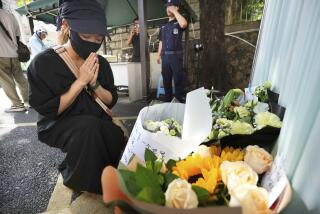Boy, 14, Arrested in Slaying That Appalled Japan
TOKYO — In a stunning development in a grotesque murder case that shocked Japan, police Saturday arrested a 14-year-old student on charges of killing a younger boy and placing his severed head in front of a schoolyard gate last month in the port city of Kobe.
The older student--suspected as the author of rambling letters boasting of murderous prowess and full of hatred for Japan’s compulsory education system--is also being investigated in the bludgeoning death of a girl, the stabbing of another girl who nearly bled to death and the killing of cats and pigeons.
In a nationally televised news conference, Hyogo prefecture police official Seishi Yamashita said the boy--whose name is being withheld--had confessed to killing Jun Hase, 11. Jun’s severed head was discovered by a school custodian May 27 with its eyes gouged out and its mouth split open from ear to ear and stuffed with a note.
“Well, now the game begins. Try and stop me, you thickheaded cops! I can’t help but enjoy killing. I want nothing more than to see people die,” said the note, which was written in Japanese but signed, in misspelled English, “SHOOLL KILLER.”
The horrifying crime shook Japan and its fabled sense of safety. The murder rate here is a fraction of that in the United States, and children routinely walk the streets alone. But after Jun’s head was discovered--police charge the youth lured him to a cable TV antenna station, strangled him in the woodsy hillside area and hid his body in the facility--the slain boy’s peaceful Kobe neighborhood was transformed into a virtual fortress.
A platoon of 400 police officers patrolled the neighborhood daily. Parents formed convoys to escort children to school and kept them away from playgrounds. The central government dispatched counselors to the area to offer consultations to parents and children suffering from anxiety over the crime--some of whom were still shaken by memories of the devastating earthquake that killed hundreds and leveled miles of buildings in the Kobe area in 1995.
Police sifted through more than 3,500 tips, and newspapers were filled with speculation that the killer was a man in his 30s or 40s, possibly a former police officer knowledgeable about ways to conceal crimes. The killer took care not to leave fingerprints, for instance, and wrote his chilling notes on a standard grade of paper nearly impossible to trace.
When police announced that the suspect is merely 14 years old, the shock was nearly as great as the disbelief surrounding the original crime.
“I can’t really take it in,” said one 60-year-old woman quoted in the Japanese press. “It is a tragedy that the suspect is a local boy.”
Criminologist Hiroaki Iwai of Toyo University said junior high school children are sometimes capable of committing horrific acts because they have not yet formed clear social values.
Yamashita of the Hyogo police said evidence linking the boy to the crime was found during a search of his house. The evidence is believed to be a knife and the red tape used to seal letters sent to the local Kobe Shimbun newspaper.
The suspect apparently knew Jun and had suggested that they play where he allegedly strangled him, Japanese media reported.
The boy’s remains were discovered three days after he disappeared en route to his grandfather’s home.
Yamashita said the murder motive was still being investigated but that the accused boy had expressed a vicious hatred for Japan’s education system, characterized by rote memorization and relentless competitive pressure to succeed in entrance exams that can begin as early as preschool.
In one 1,400-word, sometimes incoherent letter to the Kobe Shimbun, the killer said an “invisible friend” advised him to relieve his anger toward school by making murder his “hobby, raison d’etre and purpose.”
“I do not know why I love killing, even today. All I can say is that I was born with it. I can ease my own pain only by seeing others in pain,” the letter said, threatening the slaying of three people--termed “vegetables”--a week.
In an article headlined “The (Video) Game Generation: Beyond Reality,” the Asahi Shimbun newspaper speculated that the arrested boy--said to be fascinated by the occult, comic books and video games--reflected a tendency among some young Japanese to blur fantasy and reality. Sociologists here have long lamented that computer games have damaged children’s social skills and the ability to empathize with others, and they point to the rise in violence, bullying and juvenile crime among children.
In the last 12 months, juvenile crimes have sharply increased--to 133,581, the first rise in eight years--even as the youth population aged 14 to 19 has fallen. The arrests on murder charges in that total numbered 96, and roving gangs of boys preying on elderly men have made headlines.
Some observers have even criticized the wildly popular Tamagotchi video game, which features an electronic chicken, for weakening children’s sense of responsibility for their actions. That’s because even if players cause the chicken to “die” through mistreatment, they can easily restore it to life with the mere click of a button.
“All I can say is that Japanese people have changed,” one Hyogo police officer was quoted in the Japanese press as saying.
More to Read
Sign up for Essential California
The most important California stories and recommendations in your inbox every morning.
You may occasionally receive promotional content from the Los Angeles Times.











